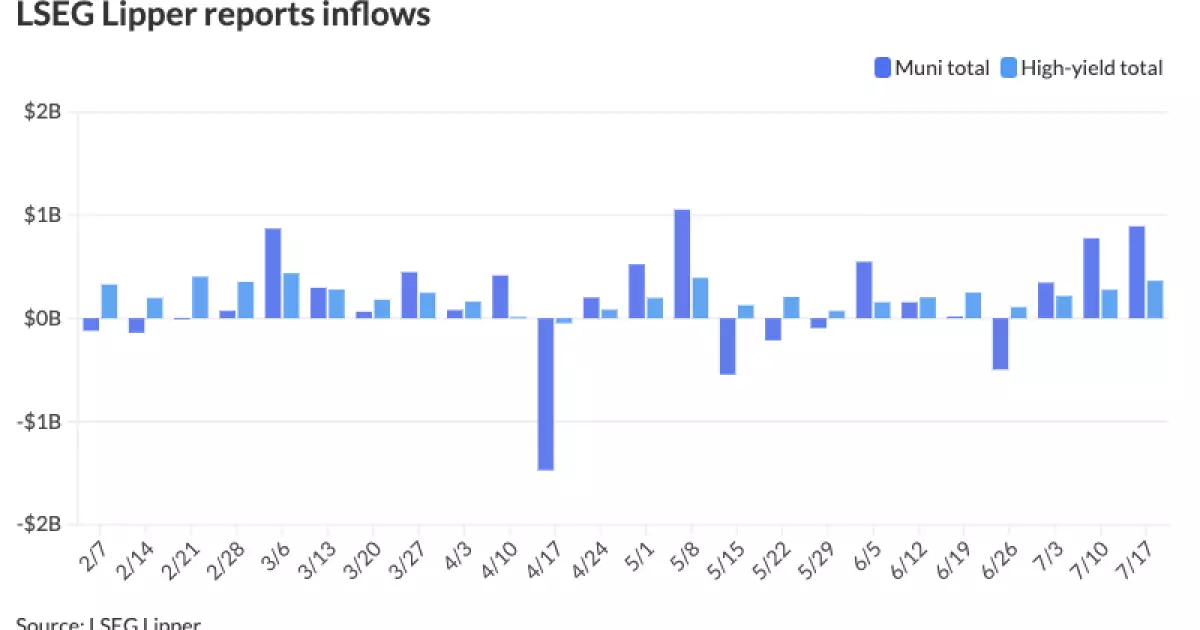The municipal bond market has exhibited a somewhat resilient trend lately, especially in the short-term segment. As we delve into the latest market movements, it becomes evident that municipal mutual funds are experiencing a steady inflow of capital, amid fluctuating external conditions marked by rising U.S. Treasury yields and a general sell-off in equities. Analyzing these shifts can offer a critical perspective on the broader implications for investors and the fiscal landscape.
According to Refinitiv Municipal Market Data, the ratios comparing municipal bonds to Treasuries reflect a stabilizing trend for various maturities, with the two-year ratio at 64% and the 30-year at 83%. These ratios indicate relative value dynamics, benefiting short-term bond holdings, especially as investors seek refuge in the perceived safety of municipal bonds amid economic uncertainties.
Continued Confidence Amid High Inflows
Recent data from LSEG Lipper indicates that municipal bond mutual funds enjoyed a significant inflow of $891.4 million, which represents an increase from the previous week’s $775.3 million. This traction underscores a growing investor confidence in municipal bonds as a viable investment vehicle, even as broader economic indicators signal a mixed outlook.
High-yield municipal bonds have similarly maintained this trend, with inflows reaching $364.4 million, a notable increase from the previous week’s figures. These inflows reflect an appetite for riskier asset classes, suggesting that investors are looking for higher returns despite the looming specter of volatility. GW&K Investment Management has highlighted a markedly improved outlook for municipal bonds in the second quarter of the year, amidst a backdrop of absolute yield reaching historical averages and relative ratios stabilizing, providing critical support against Treasury fluctuations.
The seasonal nature of the municipal bond market plays a pivotal role in shaping investor sentiment and performance. July traditionally marks a peak period for these investments, which can be attributed to the seasonally favorable timing for reinvestment flows and decreasing issuance rates. Analysts from BlackRock have noted that factors such as sustained low interest rates during summer, attractive yields, and a stable supply-demand balance collaborate to create a favorable decision-making environment for retail investors.
Moreover, the new issuance of high-quality bonds in 2024 has created a significant opportunity for investment, though it led to stagnation within market indices, which remain relatively flat year-to-date. This situation suggests a tight balance between the influx of capital and available investment avenues, particularly in high-yield segments.
After an active spell in the primary market, there has been a noticeable slowing down, particularly with the issuance of substantial bonds. Recently, Morgan Stanley priced the $624.615 million wastewater revenue bonds for the San Francisco Public Utilities Commission. The bond pricing details reveal a structured approach, particularly with green bonds reflecting emerging investor priorities towards sustainability.
Additionally, BofA Securities has ventured into the green bond arena with a significant issuance for the Metropolitan Transportation Authority, targeting $389.76 million in tax-certified dedicated bonds. The appetite for climate-conscious investments mirrors a broader trend where investors are increasingly factoring environmental considerations into their portfolios.
Upcoming large-scale issuances, including $1.7 billion from the Texas Transportation Commission and $1.2 billion from New York City, indicate a robust pipeline moving into summer. While the market experiences larger deals now, smaller bond issuance remains vital for ensuring market fluidity and continued investor engagement.
Despite promising signs in the market, analysts from GW&K have expressed caution, particularly focusing on the long end of the yield curve, which has seen a flattening trend. This alteration has subsequently squeezed out potential gains for investors, presenting risks associated with economic slowdowns ahead of the upcoming November elections. Significant political events can create an unpredictable investment landscape, and market participants should tread carefully.
It is particularly pressing for investors to consider these potential headwinds as they weigh the benefits of entering into longer-term municipal bonds against the backdrop of compressing spreads and increased volatility. Additionally, recent declines in money market fund inflows suggest a shift, with some investors possibly venturing into slightly riskier assets as they seek better returns.
The current landscape of the municipal bond market presents a mix of optimism and caution. While inflows and favorable seasonal patterns set a foundation for potential growth, the inherent risks necessitate a careful evaluation of market dynamics. As we progress through the year, keeping a vigilant eye on economic indicators, issuance trends, and investor sentiments will be critical for stakeholders navigating this complex investment environment. The municipal bond market may serve as a beacon of stability, but discerning investors must remain acutely aware of the ever-shifting tides of fiscal realities.

